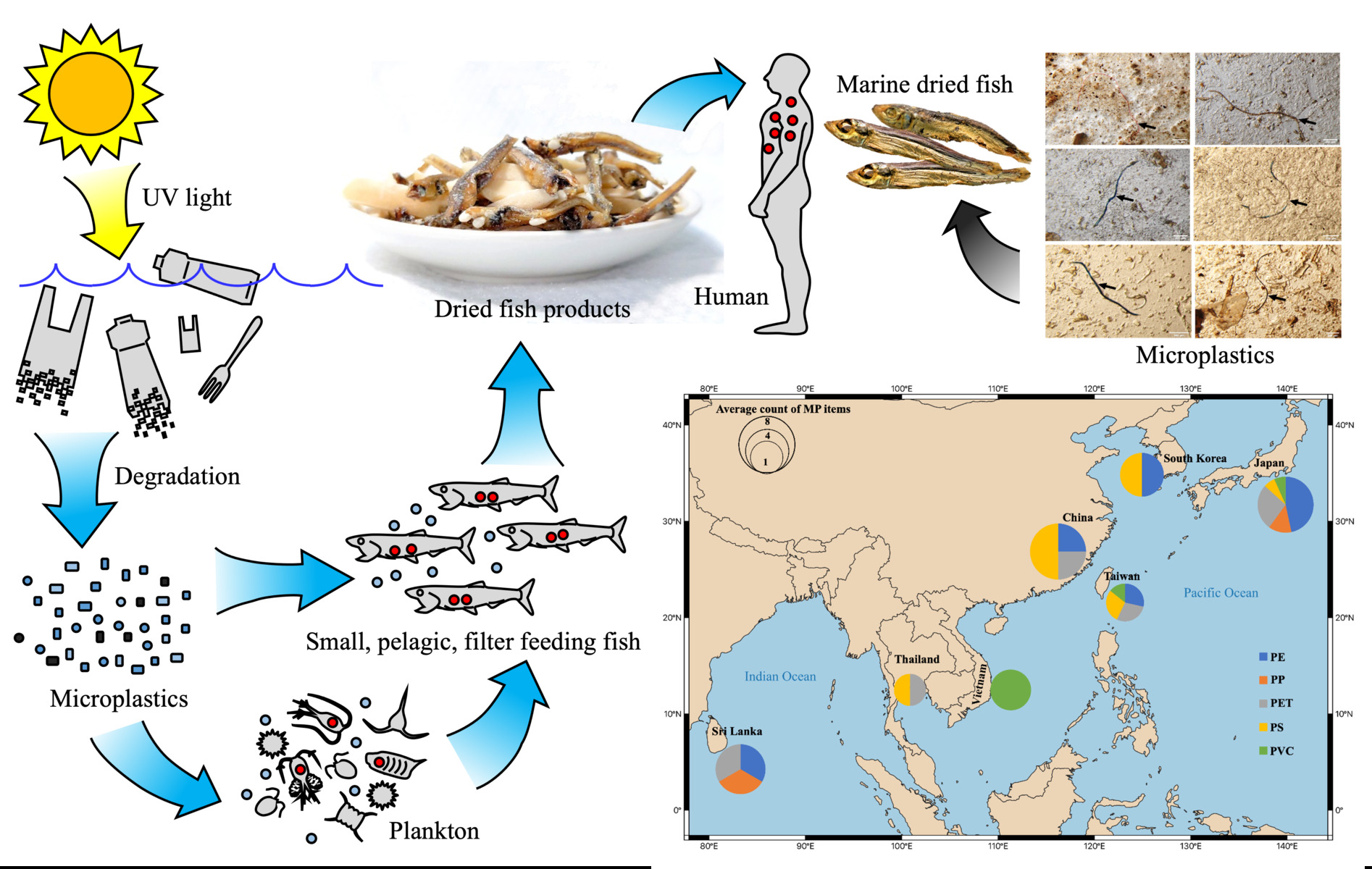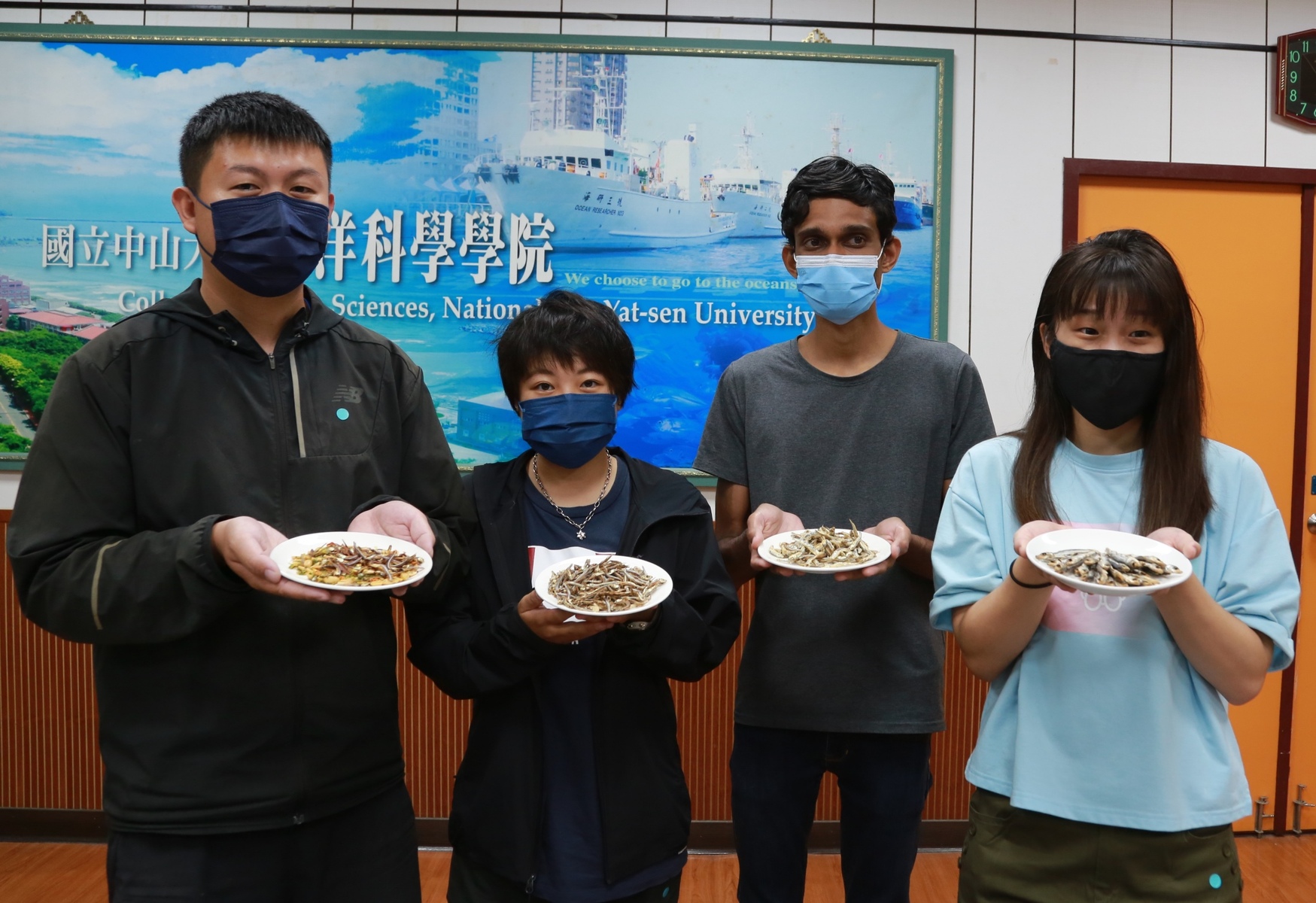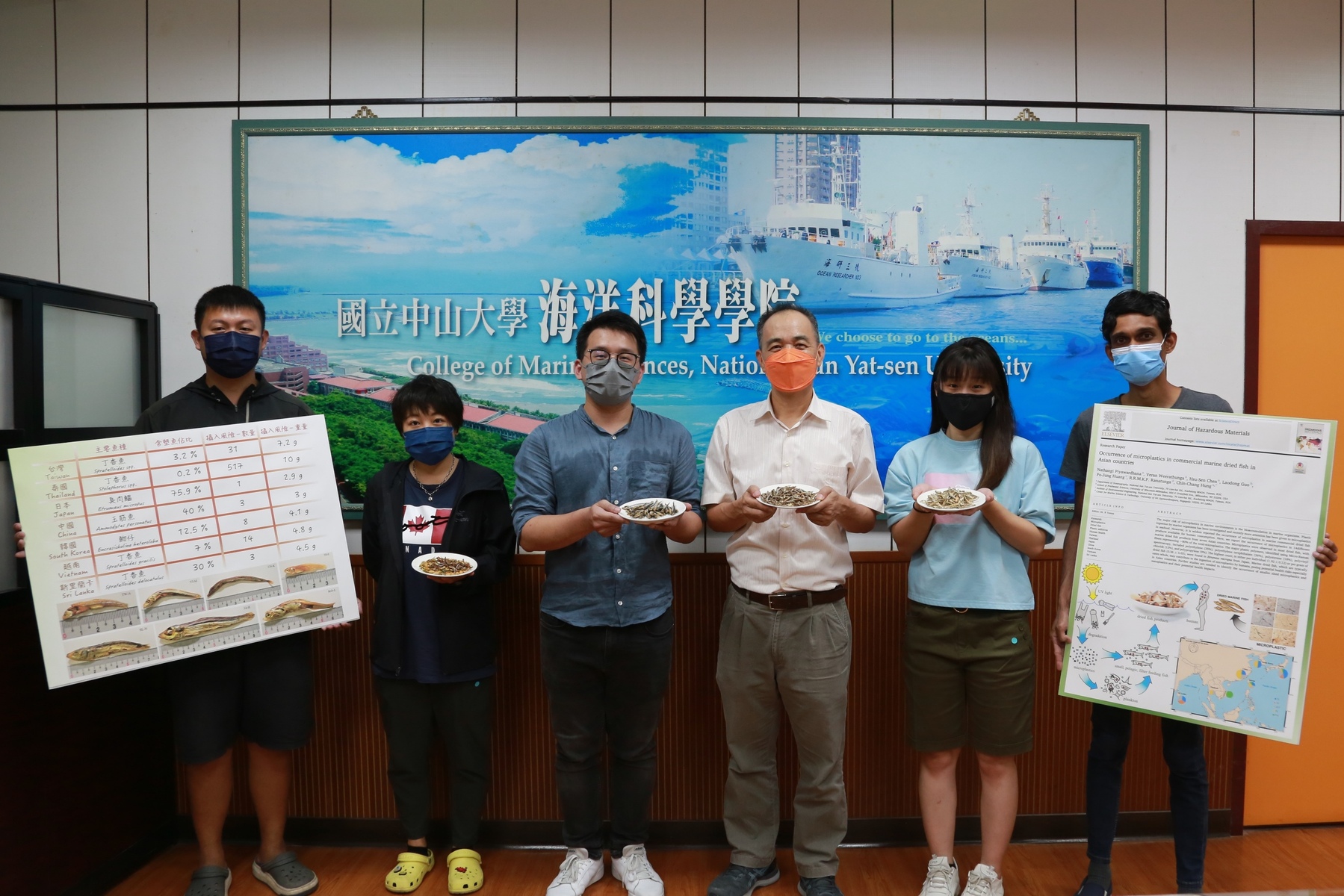The NSYSU study results published on the international leading journal: microplastics found in Asian dried fish products



Dried fishes with nuts are the classic appetizers in Taiwanese cuisine. However, recent studies indicate that people might ingest marine microplastics while eating these appetizers. National Sun Yat-sen University (NSYSU) research team announced the latest results of the study, reporting the occurrence of microplastics in 14 batches of marine dried fish from seven Asian countries. Among the investigated products, dried fish products from Japan contain averagely the most microplastics per individual, followed by products from China, Sri Lanka, South Korea, Vietnam, Taiwan and Thailand respectively. The results of the study had been published by Journal of Hazardous Materials, the international leading environmental science journal.
According to the study, the highest count per individual were found in Etrymeus micropus from Japan, the maximum was 2 pieces of microplastics per individual. The lowest count per individual were found in Stolephorus from Thailand, indicating that microplastics could be ingested with more than 500 eaten dried fishes. As for the common type of dried fish in Taiwan, silver stripe round herring, also known as clove fish, the occurrence of microplasctics was found in 3.2% of the investigated products, indicating that one piece of microplastics could be ingested with averagely 31 eaten dried clove fishes.
NSYSU research team had identified the composition of plastics with microscopy, Fourier-transform infrared spectroscopy and Micro-Raman spectroscopy, and found that the most prevalent microplastics in dried fish were fiber plastics, followed by plastic fragments, possibly caused by decomposition of large fragments and emissions of polluted water. The most common type was polyethylene. According to the research data, microplastics could be ingested with eaten 14 dried fishes from Vietnam, or eight from South Korea, or three from China/Sri Lanka. The amount of contained microplastics might vary with species and sizes. The NSYSU research team emphasized that the microplastics found in marine products from different countries would be a significant threat to human bodies.
Plastics are evidently the most commonly found marine debris. The area of the well-known “marine plastic waste graveyard” located in the ocean between east of Hawaii to California is approximately forty times larger than Taiwan, with trillions of microplastics. Those could possibly be ingested through seafood products, says Prof. Chin-Chang Hung, the dean of College of Marine Sciences, NSYSU. In previous studies, the occurrence of microplastics in oysters, mussels and clams had been identified. But relatively, there are much fewer studies of microplastics in dried fish.
Due to the dietary pattern in Asian countries, the risk of microplastics ingestion could be higher than western countries, says Prof. Chin-Chang Hung. In Asia, dried fish products made by filter feeder species, such as Engraulidae and Clupeidae, are commonly seen on dining tables. The nutrient sources of these filter feeding fishes are algaes and planktons. Thus, microplastics could be ingested through those fishes’ gill rakers.
In western countries, the most common fish products are fillets. It is less probable to ingest microplastics from gills, stomachs and internal organs of fishes. On the other hand, ingredients of Asian dried fish products usually contain internal organs of fishes, which increases the risk of microplastics ingestion for consumers.
“In order to avoid marine plastics pollutions, the actions of reducing microplastics emissions, like shopping with reusable bags, giving up plastic bags and keeping trash off the ground should be more emphasized.” says Prof. Chin-Chang Hung. Microplastics shows significant threat to marine organisms, and suggests potential human health risks. Currently, the health impact can be hardly measured. It will take more studies to assess the effects of microplastics on human bodies.
The members of the research team include Nathangi Piyawardhana from Sri Lanka, the graduate student of the Department of Marine Sciences, NSYSU, Hsu-Sen Chen, the Postdoctoral Research Fellow and the associate professor of National Pingtung University of Science and Technology, Veran Weerathunga, the doctoral student from Sri Lanka, Dr.Laodong Guo, the professor of University of Wisconsin-Milwaukee, Po-Jung Huang, the associate professor of the Institute of Environmental Engineering, NSYSU, and Dr. Kamal Ranatunga, the professor of University of Sri Jaywardenepura.
Please find the fill article as the link below.
https://www.sciencedirect.com/science/article/pii/S0304389421020616?via%3Dihub
Piyawardhana N., V. Weerathunga , H.-S. Chen , L. Guo , P.-J. Huang , R.R.M.K.P. Ranatunga , C.-C. Hung (2022) Occurrence of microplastics in commercial marine dried fish in Asian countries. Journal of Hazardous Materials, 423, 127093, DOI: https://doi.org/10.1016/j.jhazmat.2021.127093.
According to the study, the highest count per individual were found in Etrymeus micropus from Japan, the maximum was 2 pieces of microplastics per individual. The lowest count per individual were found in Stolephorus from Thailand, indicating that microplastics could be ingested with more than 500 eaten dried fishes. As for the common type of dried fish in Taiwan, silver stripe round herring, also known as clove fish, the occurrence of microplasctics was found in 3.2% of the investigated products, indicating that one piece of microplastics could be ingested with averagely 31 eaten dried clove fishes.
NSYSU research team had identified the composition of plastics with microscopy, Fourier-transform infrared spectroscopy and Micro-Raman spectroscopy, and found that the most prevalent microplastics in dried fish were fiber plastics, followed by plastic fragments, possibly caused by decomposition of large fragments and emissions of polluted water. The most common type was polyethylene. According to the research data, microplastics could be ingested with eaten 14 dried fishes from Vietnam, or eight from South Korea, or three from China/Sri Lanka. The amount of contained microplastics might vary with species and sizes. The NSYSU research team emphasized that the microplastics found in marine products from different countries would be a significant threat to human bodies.
Plastics are evidently the most commonly found marine debris. The area of the well-known “marine plastic waste graveyard” located in the ocean between east of Hawaii to California is approximately forty times larger than Taiwan, with trillions of microplastics. Those could possibly be ingested through seafood products, says Prof. Chin-Chang Hung, the dean of College of Marine Sciences, NSYSU. In previous studies, the occurrence of microplastics in oysters, mussels and clams had been identified. But relatively, there are much fewer studies of microplastics in dried fish.
Due to the dietary pattern in Asian countries, the risk of microplastics ingestion could be higher than western countries, says Prof. Chin-Chang Hung. In Asia, dried fish products made by filter feeder species, such as Engraulidae and Clupeidae, are commonly seen on dining tables. The nutrient sources of these filter feeding fishes are algaes and planktons. Thus, microplastics could be ingested through those fishes’ gill rakers.
In western countries, the most common fish products are fillets. It is less probable to ingest microplastics from gills, stomachs and internal organs of fishes. On the other hand, ingredients of Asian dried fish products usually contain internal organs of fishes, which increases the risk of microplastics ingestion for consumers.
“In order to avoid marine plastics pollutions, the actions of reducing microplastics emissions, like shopping with reusable bags, giving up plastic bags and keeping trash off the ground should be more emphasized.” says Prof. Chin-Chang Hung. Microplastics shows significant threat to marine organisms, and suggests potential human health risks. Currently, the health impact can be hardly measured. It will take more studies to assess the effects of microplastics on human bodies.
The members of the research team include Nathangi Piyawardhana from Sri Lanka, the graduate student of the Department of Marine Sciences, NSYSU, Hsu-Sen Chen, the Postdoctoral Research Fellow and the associate professor of National Pingtung University of Science and Technology, Veran Weerathunga, the doctoral student from Sri Lanka, Dr.Laodong Guo, the professor of University of Wisconsin-Milwaukee, Po-Jung Huang, the associate professor of the Institute of Environmental Engineering, NSYSU, and Dr. Kamal Ranatunga, the professor of University of Sri Jaywardenepura.
Please find the fill article as the link below.
https://www.sciencedirect.com/science/article/pii/S0304389421020616?via%3Dihub
Piyawardhana N., V. Weerathunga , H.-S. Chen , L. Guo , P.-J. Huang , R.R.M.K.P. Ranatunga , C.-C. Hung (2022) Occurrence of microplastics in commercial marine dried fish in Asian countries. Journal of Hazardous Materials, 423, 127093, DOI: https://doi.org/10.1016/j.jhazmat.2021.127093.
Click Num:
Share
